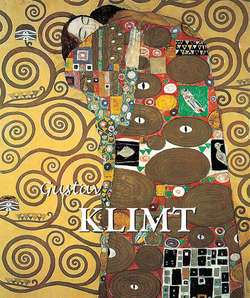Gustav Klimt

Описание книги
“I am not interested in myself as a subject for painting, but in others, particularly women…”Beautiful, sensuous and above all erotic, Gustav Klimt’s paintings speak of a world of opulence and leisure, which seems aeons away from the harsh, post-modern environment we live in now. The subjects he treats – allegories, portraits, landscapes and erotic figures – contain virtually no reference to external events, but strive rather to create a world where beauty, above everything else, is dominant. His use of colour and pattern was profoundly influenced by the art of Japan, ancient Egypt, and Byzantium. Ravenne, the flat, two-dimensional perspective of his paintings, and the frequently stylised quality of his images form an oeuvre imbued with a profound sensuality and one where the figure of woman, above all, reigns supreme. Klimt’s very first works brought him success at an unusually young age. Gustav, born in 1862, obtained a state grant to study at Kunstgewerbeschule (the Vienna School of Arts and Crafts) at the age of fourteen. His talents as a draughtsman and painter were quickly noticed, and in 1879 he formed the Künstlercompagnie (Artists’ Company) with his brother Ernst and another student, Franz Matsch. The latter part of the nineteenth century was a period of great architectural activity in Vienna. In 1857, the Emperor Franz Joseph had ordered the destruction of the fortifications that had surrounded the medieval city centre. The Ringstrasse was the result, a budding new district with magnificent buildings and beautiful parks, all paid for by public expenses. Therefore the young Klimt and his partners had ample opportunities to show off their talents, and they received early commissions to contribute to the decorations for the pageant organised to celebrate the silver wedding anniversary of the Emperor Franz Joseph and the Empress Elisabeth. In 1894, Matsch moved out of their communal studio, and in 1897 Klimt, together with his closest friends, resigned from the Künstlerhausgenossenschaft (the Cooperative Society of Austrian Artists) to form a new movement known as the Secession, of which he was immediately elected president. The Secession was a great success, holding both a first and second exhibition in 1898. The movement made enough money to commission its very own building, designed for it by the architect Joseph Maria Olbrich. Above the entrance was its motto: “To each age its art, to art its freedom.” From around 1897 onward, Klimt spent almost every summer on the Attersee with the Flöge family. These were periods of peace and tranquillity in which he produced the landscape paintings constituting almost a quarter of his entire oeuvre. Klimt made sketches for virtually everything he did. Sometimes there were over a hundred drawings for one painting, each showing a different detail – a piece of clothing or jewellery, or a simple gesture. Just how exceptional Gustav Klimt was is perhaps reflected in the fact that he had no predecessors and no real followers. He admired Rodin and Whistler without slavishly copying them, and was admired in turn by the younger Viennese painters Egon Schiele and Oskar Kokoschka, both of whom were greatly influenced by Klimt.
Оглавление
Patrick Bade. Gustav Klimt
The Viennese Secession
His Life
Beginnings
Secession
Scandal
Fin de Siècle Vienna
Lovers and Friends
Drawings and Sketches
Society Portraits
Pattern and Nudity
Klimt’s Legacy
His Work
Fable
The Idyll
The Theatre of Taormina
Female Nude Lying Down
Auditorium of the Old Burgtheater
Portrait of Joseph Pembaur
Ancient Greek Art I
The Love
Music I
Final Drawing for the Allegory of Tragedy
Fish Blood
Compositional Project for Medicine
Pallas Athena
Potrait of Sonja Knips
Exhibition Wallpaper for Secession I
Nuda Veritas
Nuda Veritas (Detail)
Schubert at Piano
Two Lovers
Island on the Attersee
Goldfish
Judith I
Portrait of Gertha Felsovanyi
The Beethoven Frieze: Ambition, Compassion and the Knight in Shining Armor (Detail)
Potrait of Emilie Flöge
Forest Of Beech Trees I
Hope I
Water Snake I
Water Snake II
The Three Ages of Women
Potrait of Margaret Stonborough-Wittgenstein
The Stoclet Frieze (Detail)
Sunflower Garden
Potrait of Fretza Riedler
Medicine
Hygieia (Detail of Medicine)
Potrait of Adele Bloch-Bauer I
Hope II
The Kiss
The Kiss (Detail)
Danaë
Kammer Castle on the Attersee I
Woman in Hat with Feather Boa
Judith II
The Black Feather Hat
Life and Death
Garden With Crucifix
Farmhouse in Upper Austria
Potrait of Adele Bloch-Bauer Ii
Ria Munk on Her Death Bed
Portrait of Mäda Primavesi
Potrait of Eugenia Primavesi
Virgin
Malcesine on Lake Garda
Potrait of Elisabeth Bachfen-Echt
House at Unterach on the Attersee
Potrait of Friederike Maria Beer
Path of Garden and Hens
The Church at Unterach on the Attersee
Girlfriends (Detail)
Baby
Adam and Eve (Unfinished)
Dancer
Bride (Unfinished)
Biography
Отрывок из книги
Gnawing Sorrow (detail from second panel of The Beethoven Frieze), 1902.
Casin on plaster, height: 220 cm.
.....
Left: Greek Art, 1890–1891.
Oil on plaster, 230 × 80 cm.
.....
